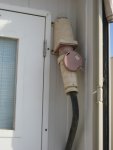- Location
- Lockport, IL
- Occupation
- Semi-Retired Electrical Engineer
I have an overseas application. British standards apply for the most part, but the NEC is sometimes a player. The following appears on a cable at an existing facility: ?3/25mm2 cu/xlpe/swa/pvc bs 457 national cable industry.?
So this is a three conductor, equivalent to #4 AWG, copper, with cross-linked polyethylene insulation, and is steel wire armoured (British spelling of that word). I am not sure how PVC comes into the picture, a search for BS 457 got me nowhere, and I can?t match the description to anything in table 400.4.
The cable is connected to a large plug that serves to bring power to a 40 foot shipping container that was configured as a living unit. We are relocating a number of these units, and are supposed to retain their existing power feed configuration. But I wonder if the cable falls under article 400. If it does, then I think this installation would run afoul of one or more of the ?uses not allowed? per 400.8.
So my question is, does article 400 apply to this type of cable?
In the attached photo, the cable is within a protective plastic covering.

So this is a three conductor, equivalent to #4 AWG, copper, with cross-linked polyethylene insulation, and is steel wire armoured (British spelling of that word). I am not sure how PVC comes into the picture, a search for BS 457 got me nowhere, and I can?t match the description to anything in table 400.4.
The cable is connected to a large plug that serves to bring power to a 40 foot shipping container that was configured as a living unit. We are relocating a number of these units, and are supposed to retain their existing power feed configuration. But I wonder if the cable falls under article 400. If it does, then I think this installation would run afoul of one or more of the ?uses not allowed? per 400.8.
So my question is, does article 400 apply to this type of cable?
In the attached photo, the cable is within a protective plastic covering.

